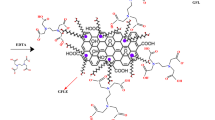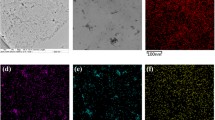Abstract
Graphene oxide (GO) prepared by modified hummers method was used as adsorbent for removal of heavy metal ions. The oxygenous functional groups on the surface of GO were primarily responsible for the sorption of metal ions. The effects of the parameters of pH value, contact time, Cu(II) concentration, and adsorbent dosage on adsorption were examined. The sorption process conformed to the Freundlich isotherm, and the maximum sorption capacity of 117.5 mg g−1 was observed at an initial pH value of 5.3 after agitating for 150 min. It was also found that Cu-pretreated GO could be desorbed by HCl and the reusability of GO could still maintain above 90 % of its initial capability after ten cycles. The results suggest that GO is an effective adsorbent for copper ions removal in water treatment.








Similar content being viewed by others
References
Atieh, M. A., Bakather, O. Y., Tawabini, B. S., Bukhari, A. A., et al. (2010). Removal of chromium(III) from water by using modified and nonmodified carbon nanotubes. Journal of Nanomaterials. doi:10.1155/2010/232378.
Badruddoza, A. Z. M., Tay, A. S. H., Tan, P. Y., Hidajat, K., & Uddin, M. S. (2011). Carboxymethyl-β-cyclodextrin conjugated magnetic nanoparticles as nano-adsorbents for removal of copper ions: synthesis and adsorption studies. Journal of Hazardous Materials, 185, 1177–1186.
Babel, S., & Kurniawan, T. G. (2003). Low-cost adsorbents for heavy metals uptake from contaminated water: a review. Journal of Hazardous Materials, B97, 219–243.
Basci, N., Kocadagistan, E., & Kocadagistan, B. (2004). Biosorption of copper(II) from aqueous solutions by wheat shell. Desalination, 164(2), 135–140.
Becerril, H. A., Mao, J., Liu, Z., Stoltenberg, R. M., Bao, Z., & Chen, Y. (2008). Evaluation of solution-processed reduced graphene oxide films as transparent conductors. ACS Nano, 2, 463–470.
Dabrowski, A., Hubicki, Z., Podkościelny, P., & Robens, E. (2004). Selective removal of the heavy metal ions from waters and industrial wastewaters by ion-exchange method. Chemosphere, 56, 91–106.
Ho, Y. S., & Ofomaja, A. E. (2006). Kinetic studies of copper ion adsorption on palm kernel fibre. Journal of Hazardous Materials, B137, 1796–1802.
Hummers, W. S., & Offeman, R. E. (1958). Preparation of graphitic oxide. Journal of the American Chemical Society, 80, 1339.
Huang, Z. H., Zheng, X., Lv, W., Wang, M., Yang, Q. H., & Kang, F. (2011). Adsorption of lead(II) ions from aqueous solution on low-temperature exfoliated graphene nanosheets. Langmuir, 27, 7558–7562.
Imamoglu, M., & Tekir, O. (2008). Removal of copper(II) and lead(II) ions from aqueous solutions by adsorption on activated carbon from a new precursor hazelnut husks. Desalination, 228, 108–113.
Janin, A., Zaviska, F., Drogui, P., Blais, J. F., & Mercier, G. (2009). Selective recovery of metals in leachate from chromated copper arsenate treated wastes using electrochemical technology and chemical precipitation. Hydrometallurgy, 96, 318–326.
Kovtyukhova, N. I., Ollivier, P. J., Martin, B. R., Mallouk, T. E., Chizhik, S. A., Buzaneva, E. V., & Gorchinskiy, A. D. (1999). Layer-by-layer assembly of ultrathin composite films from micron-sized graphite oxide sheets and polycations. Chemistry of Materials, 11, 771–778.
Kuo, C. Y. (2009). Water purification of removal aqueous copper (II) by as-grown and modified multi-walled carbon nanotubes. Desalination, 249, 781–785.
Li, J., Chen, S., Sheng, G., Hu, J., Tan, X., & Wang, X. (2011). Effect of surfactants on Pb(II) adsorption from aqueous solutions using oxidized multiwall carbon nanotubes. Chemical Engineering Science, 166, 551–558.
Li, Y. H., Luan, Z., Xiao, X., Zhou, X., Xu, C., Wu, D., & Wei, B. (2003). Removal of Cu2+ ions from aqueous solutions by carbon nanotubes. Adsorption Science and Technology, 21, 475–485.
Machida, M., Mochimaru, T., & Tatsumoto, H. (2006). Lead(II) adsorption onto the graphene layer of carbonaceous materials in aqueous solution. Carbon, 44, 2681–2688.
Madadrang, C. J., Kim, H. Y., Gao, G., Wang, N., Zhu, J., Feng, H., et al. (2012). Adsorption behavior of EDTA-graphene oxide for Pb(II) removal. Applied Materials & Interfaces, 4(3), 1186–1193.
Murugan, A. V., Muraliganth, T., & Manthiram, A. (2009). Rapid, facile microwave-solvothermal synthesis of graphene nanosheets and their polyaniline nanocomposites for energy storage. Chemistry of Materials, 21, 5004–5006.
Soylak, M., Unsal, Y. E., Kizil, N., & Aydin, A. (2010). Utilization of membrane filtration for preconcentration and determination of Cu(II) and Pb(II) in food, water and geological samples by atomic absorption spectrometry. Food and Chemical Toxicology, 48, 517–521.
Sprynskyy, M., Buszewski, B., Terzyk, A. P., & Namieśnik, J. (2006). Study of the selection mechanism of heavy metal (Pb2+, Cu2+, Ni2+, and Cd2+) adsorption on clinoptilolite. Journal of Colloid and Interface Science, 304, 21–28.
Tofighy, M. A., & Mohammadi, T. (2011). Adsorption of divalent heavy metal ions from water using carbon nanotube sheets. Journal of Hazardous Materials, 185, 140–147.
Veli, S., & Alyüz, B. (2007). Adsorption of copper and zinc from aqueous solutions by using natural clay. Journal of Hazardous Materials, 149, 226–233.
Wang, X. S., Li, Z. Z., & Sun, C. (2009). A comparative study of removal of Cu(II) from aqueous solutions by locally low-cost materials: marine macroalgae and agricultural by-products. Desalination, 235, 146–159.
Wong, K. K., Lee, C. K., Low, K. S., & Haron, M. J. (2003). Removal of Cu and Pb by tartaric acid modified rice husk from aqueous solutions. Chemosphere, 50, 23–28.
Wu, Y., Zhang, L., Gao, C., Ma, J., Ma, X., & Han, R. (2009). Adsorption of copper ions and methylene blue in a single and binary system on wheat straw. Journal of Chemical & Engineering Data, 54, 3229–3234.
Yu, B., Zhang, Y., Shukla, A., Shukla, S. S., & Dorris, K. L. (2000). The removal of heavy metal from aqueous solutions by sawdust adsorption—removal of copper. Journal of Hazardous Materials, B80, 33–42.
Zhao, F., Yu, B., Yue, Z., Wang, T., Wen, X., Liu, Z., & Zhao, C. (2007). Preparation of porous chitosan gel beads for copper(II) ion adsorption. Journal of Hazardous Materials, 147, 67–73.
Zhao, G., Ren, X., Gao, X., Tan, X., Li, J., Chen, C., Huang, Y., & Wang, X. (2011a). Removal of Pb(II) ions from aqueous solutions on few-layered graphene oxide nanosheets. Dalton Transactions, 40, 10945–10952.
Zhao, G., Li, J., Ren, X., Chen, C., & Wang, X. (2011b). Few-layered graphene oxide nanosheets as superior sorbents for heavy metal ion pollution management. Environment Science Technology, 45, 10454–10462.
Acknowledgments
This work was supported by National Natural Science Foundation of China (grant no. 51071067, 21271069, 51238002, J1210040,) and Science and Technology Program of Hunan Province (2011GK3136).
Author information
Authors and Affiliations
Corresponding author
Rights and permissions
About this article
Cite this article
Wu, W., Yang, Y., Zhou, H. et al. Highly Efficient Removal of Cu(II) from Aqueous Solution by Using Graphene Oxide. Water Air Soil Pollut 224, 1372 (2013). https://doi.org/10.1007/s11270-012-1372-5
Received:
Accepted:
Published:
DOI: https://doi.org/10.1007/s11270-012-1372-5




